engine HONDA CR-V 2012 RM1, RM3, RM4 / 4.G Owners Manual
[x] Cancel search | Manufacturer: HONDA, Model Year: 2012, Model line: CR-V, Model: HONDA CR-V 2012 RM1, RM3, RM4 / 4.GPages: 361, PDF Size: 7.25 MB
Page 2 of 361
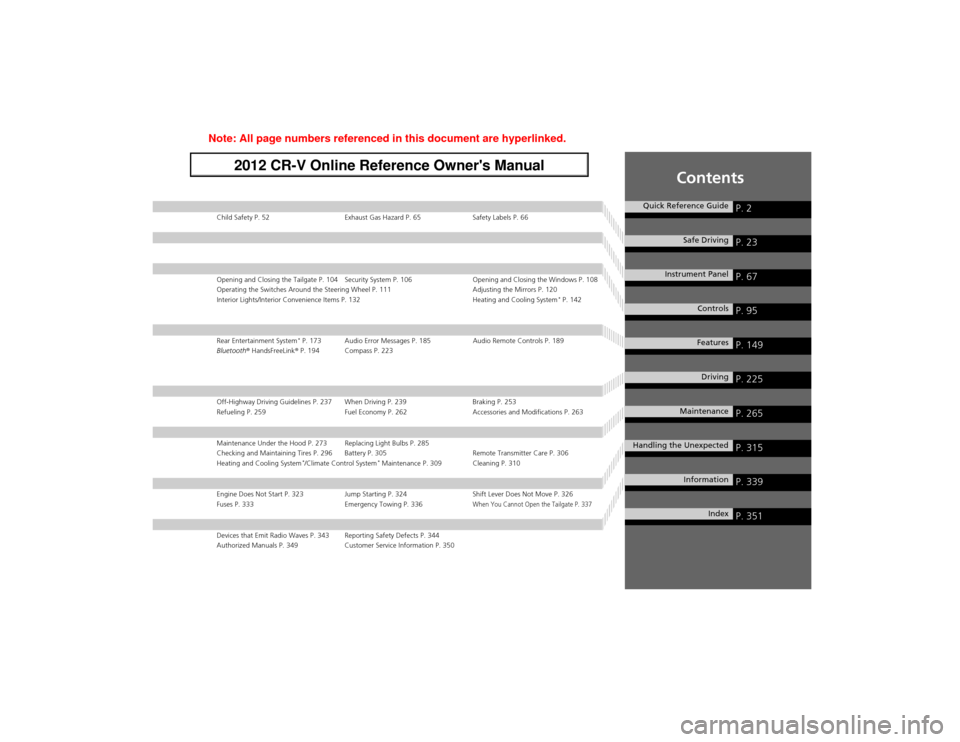
Contents
Child Safety P. 52 Exhaust Gas Hazard P. 65 Safety Labels P. 66
Opening and Closing the Tailgate P. 104 Security System P. 106 Opening and Closing the Windows P. 108
Operating the Switches Around the Steering Wheel P. 111 Adjusting the Mirrors P. 120
Interior Lights/Interior Convenience Items P. 132 Heating and Cooling System*
P. 142
Rear Entertainment System *
P. 173 Audio Error Messages P. 185 Audio Remote Controls P. 189
Bluetooth ® HandsFreeLink ® P. 194 Compass P. 223
Off-Highway Driving Guidelines P. 237 When Driving P. 239 Braking P. 253
Refueling P. 259 Fuel Economy P. 262 Accessories and Modifications P. 263
Maintenance Under the Hood P. 273 Replacing Light Bulbs P. 285
Checking and Maintaining Tires P. 296 Battery P. 305 Remote Transmitter Care P. 306
Heating and Cooling System *
/Climate Control System *
Maintenance P. 309 Cleaning P. 310
Engine Does Not Start P. 323 Jump Starting P. 324 Shift Lever Does Not Move P. 326
Fuses P. 333 Emergency Towing P. 336When You Cannot Open the Tailgate P. 337
Devices that Emit Radio Waves P. 343 Reporting Safety Defects P. 344
Authorized Manuals P. 349 Customer Service Information P. 350
Quick Reference GuideP. 2
Safe DrivingP. 23
Instrument PanelP. 67
ControlsP. 95
FeaturesP. 149
DrivingP. 225
MaintenanceP. 265
Handling the UnexpectedP. 315
InformationP. 339
IndexP. 351
Note: All page numbers referenced in this document are hyperlinked.
2012 CR-V Online Reference Owner's Manual
Page 9 of 361
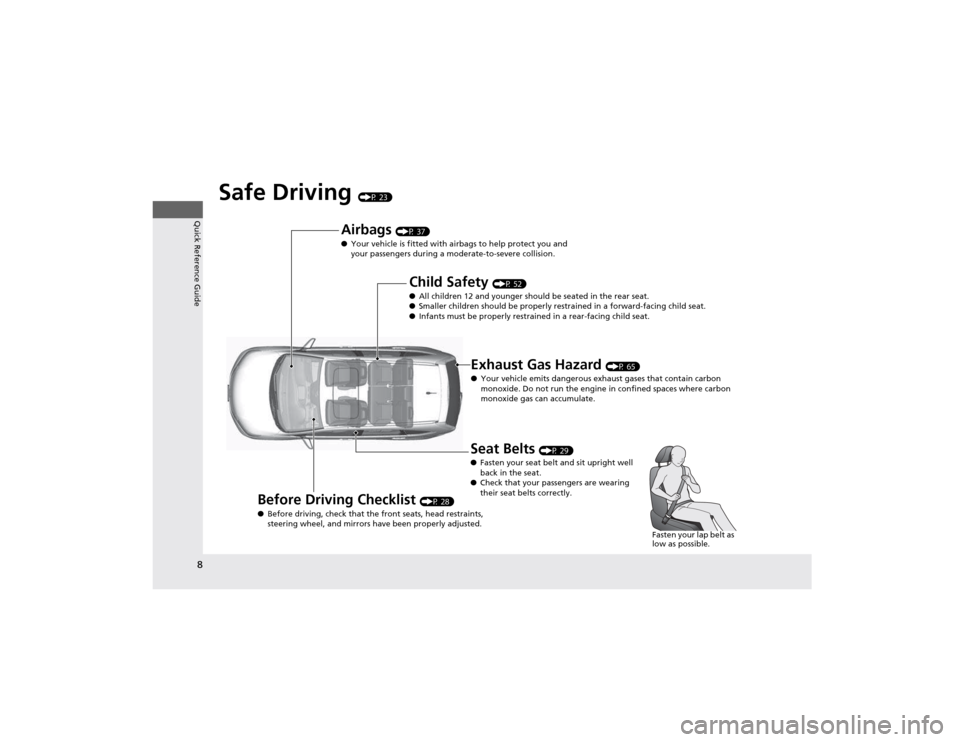
8
Quick Reference Guide
Safe Driving (P 23)
Airbags (P 37)
● Your vehicle is fitted with airbags to help protect you and
your passengers during a moderate-to-severe collision.
Child Safety (P 52)
● All children 12 and younger should be seated in the rear seat.
● Smaller children should be properly restrained in a forward-facing child seat.
● Infants must be properly restrained in a rear-facing child seat.
Exhaust Gas Hazard (P 65)
● Your vehicle emits dangerous exhaust gases that contain carbon
monoxide. Do not run the engine in confined spaces where carbon
monoxide gas can accumulate.
Before Driving Checklist (P 28)
● Before driving, check that the front seats, head restraints,
steering wheel, and mirrors have been properly adjusted. Seat Belts
(P 29)
● Fasten your seat belt and sit upright well
back in the seat.
● Check that your passengers are wearing
their seat belts correctly.
Fasten your lap belt as
low as possible.
Page 16 of 361
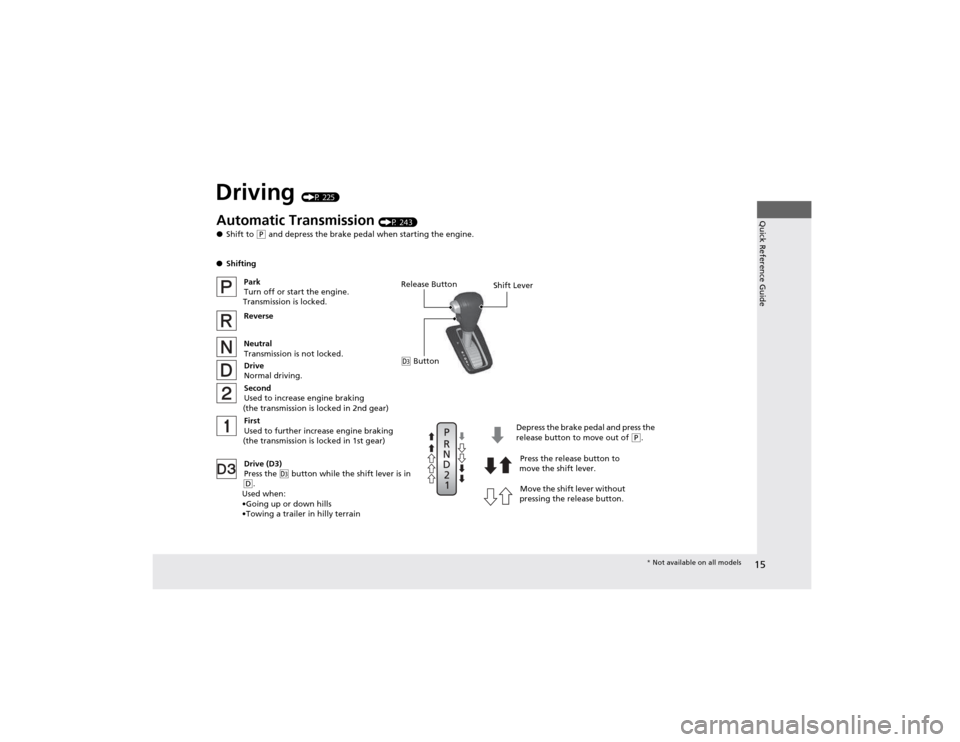
15
Quick Reference Guide
Driving (P 225)
Release Button
Shift Lever
Depress the brake pedal and press the
release button to move out of
(P.
Move the shift lever without
pressing the release button. Press the release button to
move the shift lever.
Automatic Transmission
(P 243)
● Shift to
(P and depress the brake pedal when starting the engine.
● Shifting
Park
Turn off or start the engine.
Transmission is locked.
Reverse
Neutral
Transmission is not locked.
Drive
Normal driving.
Drive (D3) Press the
(d button while the shift lever is in (D.
Used when:
•Going up or down hills
•Towing a trailer in hilly terrain Second
Used to increase engine braking
(the transmission is locked in 2nd gear)
First
Used to further increase engine braking
(the transmission is locked in 1st gear)
(d Button
* Not available on all models
Page 17 of 361
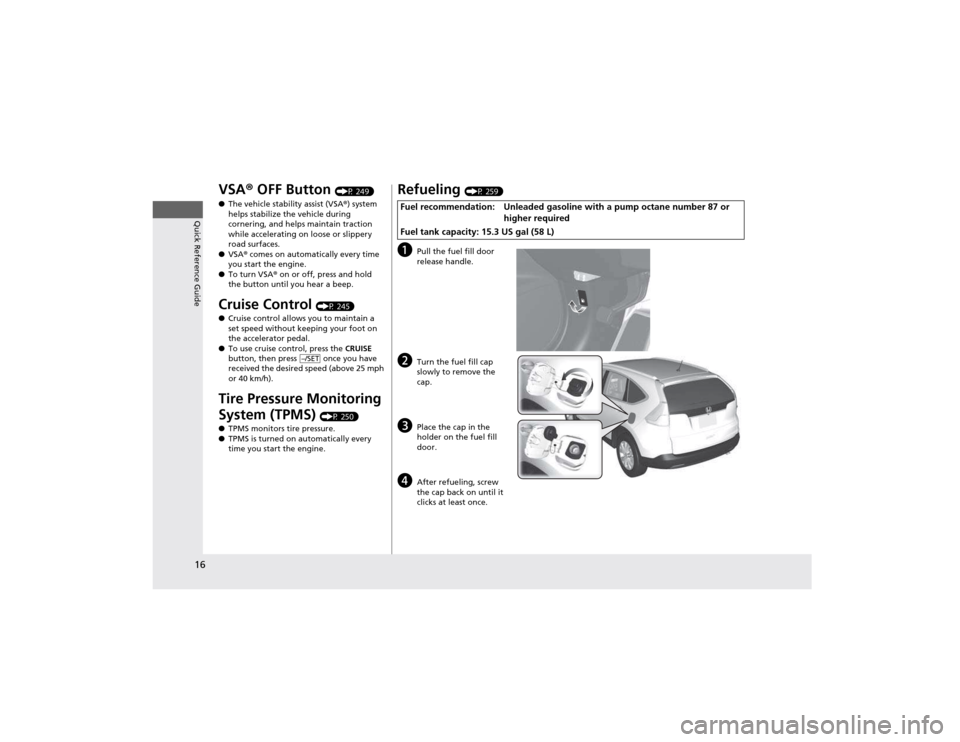
16
Quick Reference Guide
VSA® OFF Button (P 249)
● The vehicle stability assist (VSA ®) system
helps stabilize the vehicle during
cornering, and helps maintain traction
while accelerating on loose or slippery
road surfaces.
● VSA ® comes on automatically every time
you start the engine.
● To turn VSA ® on or off, press and hold
the button until you hear a beep.
Cruise Control (P 245)
● Cruise control allows you to maintain a
set speed without keeping your foot on
the accelerator pedal.
● To use cruise control, press the CRUISE
button, then press once you have
received the desired speed (above 25 mph or 40 km/h).
Tire Pressure Monitoring System (TPMS) (P 250)
● TPMS monitors tire pressure.
● TPMS is turned on automatically every
time you start the engine.
–/SET
Refueling (P 259)
a Pull the fuel fill door
release handle.
b Turn the fuel fill cap
slowly to remove the cap.
c Place the cap in the
holder on the fuel fill
door.
d After refueling, screw
the cap back on until it
clicks at least once.
Fuel recommendation: Unleaded gasoline with
a pump octane number 87 or
higher required
Fuel tank capacity: 15.3 US gal (58 L)
Page 18 of 361
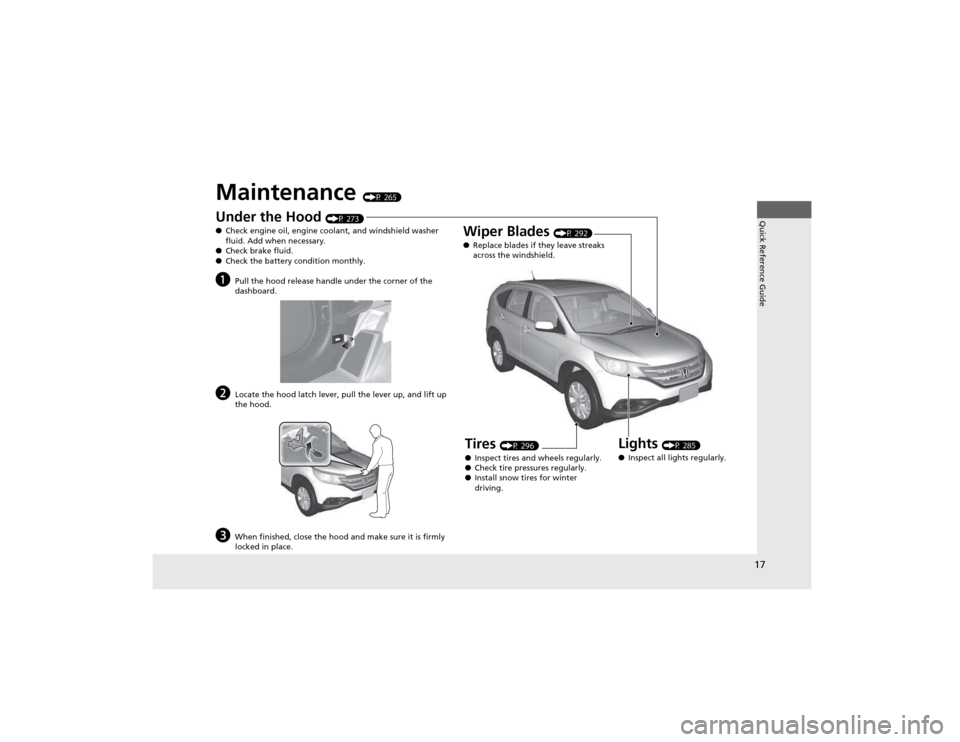
17
Quick Reference Guide
Maintenance (P 265)
Under the Hood (P 273)
● Check engine oil, engine coolant, and windshield washer
fluid. Add when necessary.
● Check brake fluid.
● Check the battery condition monthly.
a Pull the hood release handle under the corner of the
dashboard.
b Locate the hood latch lever, pull the lever up, and lift up
the hood.
c When finished, close the hood and make sure it is firmly
locked in place.
Lights (P 285)
● Inspect all lights regularly.
Wiper Blades
(P 292)
● Replace blades if they leave streaks
across the windshield.
Tires (P 296)
● Inspect tires and wheels regularly.
● Check tire pressures regularly.
● Install snow tires for winter
driving.
Page 19 of 361
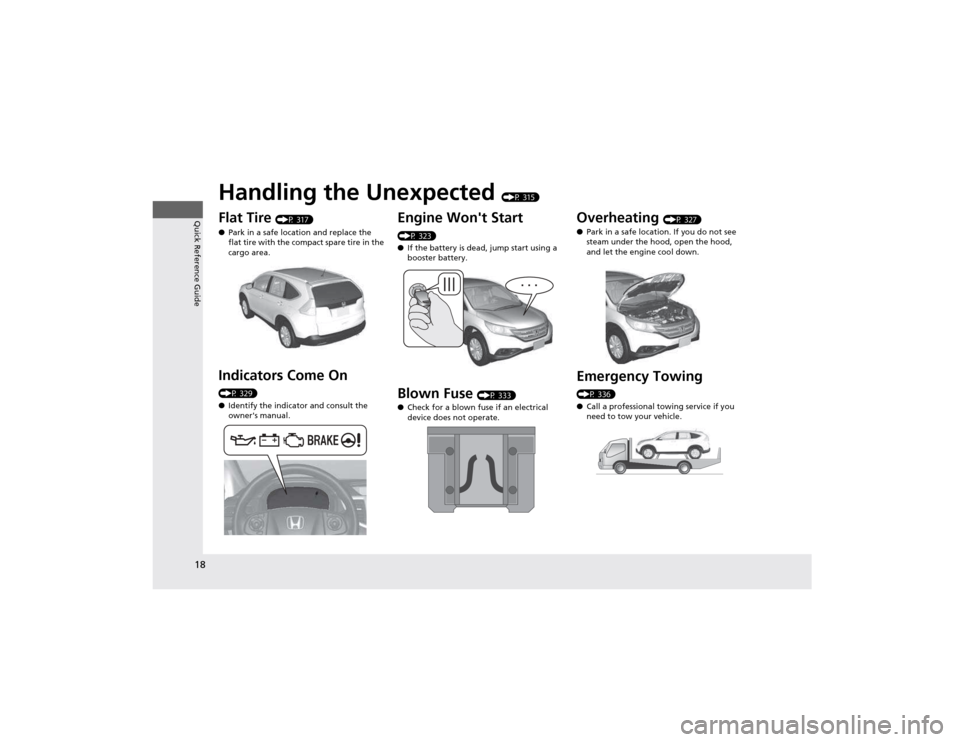
18
Quick Reference Guide
Handling the Unexpected (P 315)
Flat Tire (P 317)
● Park in a safe location and replace the
flat tire with the compact spare tire in the
cargo area.
Indicators Come On
(P 329) ● Identify the indicator and consult the
owner's manual.
Engine Won't Start
(P 323) ●If the battery is dead, jump start using a
booster battery.
Blown Fuse (P 333)
● Check for a blown fuse if an electrical
device does not operate.Overheating (P 327)
● Park in a safe location. If you do not see
steam under the hood, open the hood,
and let the engine cool down.
Emergency Towing
(P 336) ● Call a professional towing service if you
need to tow your vehicle.
Page 66 of 361
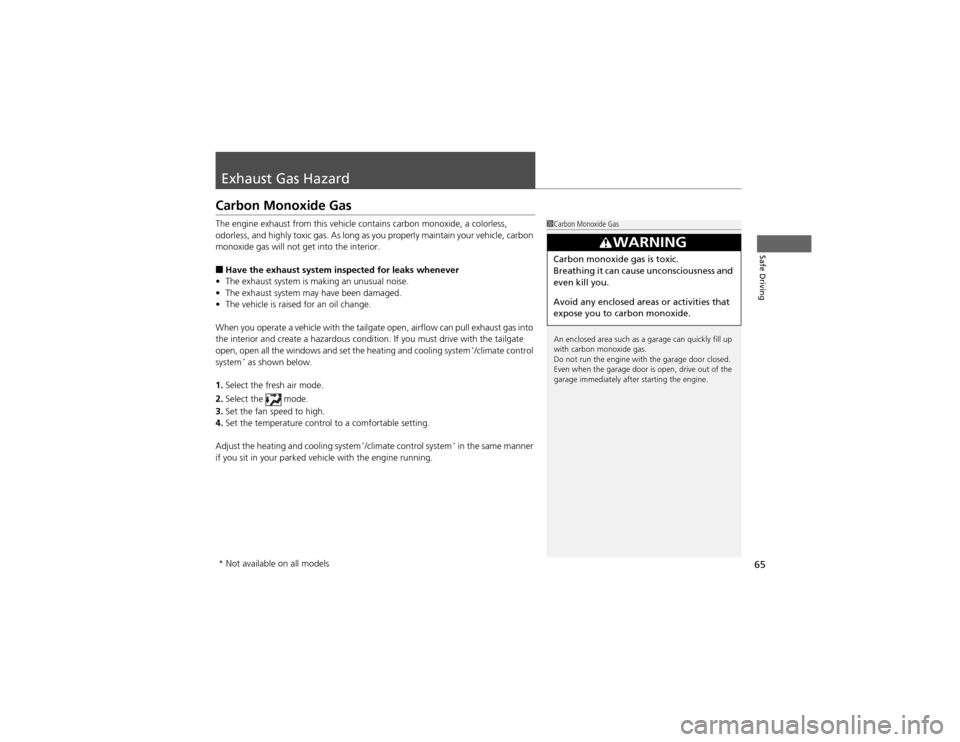
65
Safe Driving
Exhaust Gas Hazard
Carbon Monoxide Gas
The engine exhaust from this vehicle contains carbon monoxide, a colorless,
odorless, and highly toxic gas. As long as you properly maintain your vehicle, carbon
monoxide gas will not get into the interior. ■Have the exhaust system inspected for leaks whenever
• The exhaust system is making an unusual noise.
• The exhaust system may have been damaged.
• The vehicle is raised for an oil change.
When you operate a vehicle with the tailgate open, airflow can pull exhaust gas into
the interior and create a hazardous condition. If you must drive with the tailgate
open, open all the windows and set the heating and cooling system *
/climate control
system *
as shown below.
1. Select the fresh air mode.
2. Select the mode.
3. Set the fan speed to high.
4. Set the temperature control to a comfortable setting.
Adjust the heating and cooling system *
/climate control system *
in the same manner
if you sit in your parked vehicle with the engine running.
1Carbon Monoxide Gas
An enclosed area such as a garage can quickly fill up with carbon monoxide gas.
Do not run the engine with the garage door closed.
Even when the garage door is open, drive out of the
garage immediately after starting the engine.
3WARNING
Carbon monoxide gas is toxic.
Breathing it can cause unconsciousness and
even kill you.
Avoid any enclosed areas or activities that
expose you to carbon monoxide.
* Not available on all models
Page 69 of 361
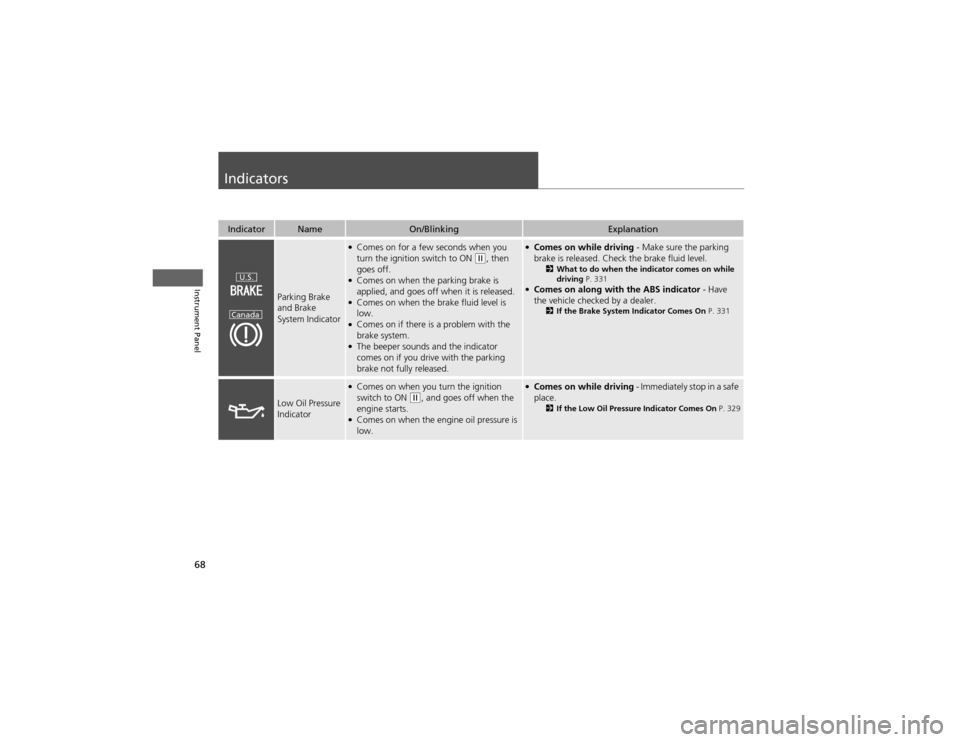
68
Instrument Panel
Indicators
IndicatorNameOn/BlinkingExplanation
Parking Brake and Brake
System Indicator
●Comes on for a few seconds when you
turn the ignition switch to ON
(w , then
goes off.
● Comes on when the parking brake is
applied, and goes off when it is released.
● Comes on when the brake fluid level is
low.
● Comes on if there is a problem with the
brake system.
● The beeper sounds and the indicator
comes on if you drive with the parking
brake not fully released.
● Comes on while driving - Make sure the parking
brake is released. Check the brake fluid level. 2What to do when the indicator comes on while
driving P. 331
● Comes on along with the ABS indicator - Have
the vehicle checked by a dealer. 2If the Brake System Indicator Comes On P. 331
Low Oil Pressure
Indicator
●
Comes on when you turn the ignition
switch to ON
(w , and goes off when the
engine starts.
● Comes on when the engine oil pressure is
low.
● Comes on while driving - Immediately stop in a safe
place. 2If the Low Oil Pressure Indicator Comes On P. 329
U.S.
Canada
Page 70 of 361
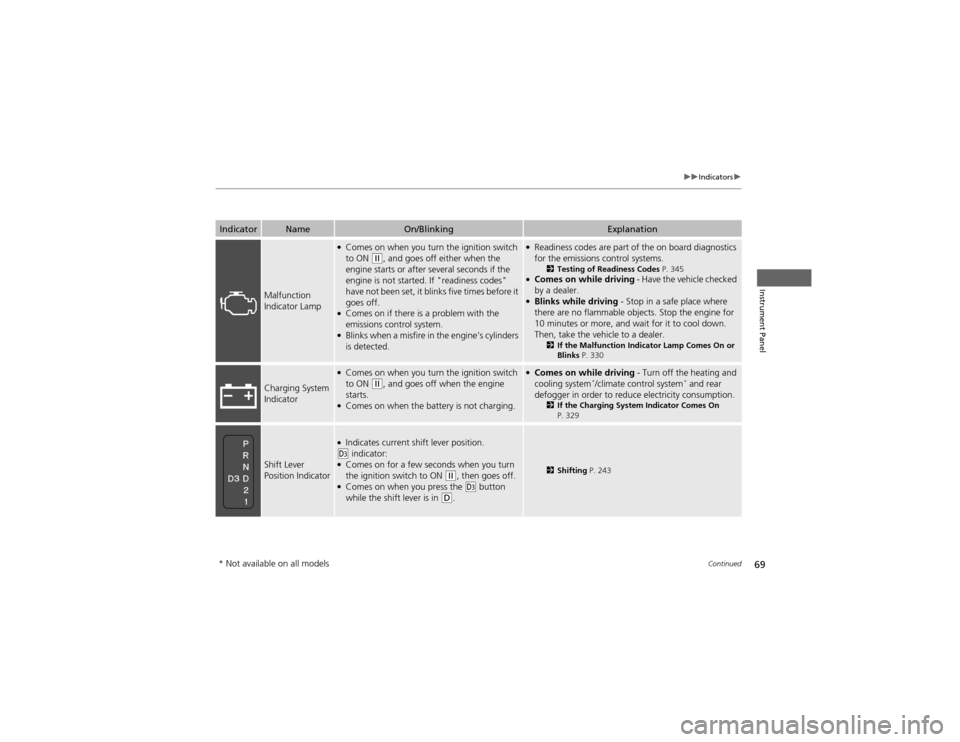
69
uuIndicatorsu
Continued
Instrument Panel
IndicatorNameOn/BlinkingExplanation
Malfunction
Indicator Lamp
●Comes on when you turn the ignition switch to ON
(w , and goes off either when the
engine starts or after several seconds if the
engine is not started. If "readiness codes"
have not been set, it blinks five times before it goes off.
● Comes on if there is a problem with the
emissions control system.
● Blinks when a misfire in the engine's cylinders
is detected.
● Readiness codes are part of the on board diagnostics
for the emissions control systems.
2Testing of Readiness Codes P. 345
● Comes on while driving - Have the vehicle checked
by a dealer.
● Blinks while driving - Stop in a safe place where
there are no flammable objects. Stop the engine for
10 minutes or more, and wait for it to cool down.
Then, take the vehicle to a dealer. 2If the Malfunction Indicator Lamp Comes On or
Blinks P. 330
Charging System
Indicator
●
Comes on when you turn the ignition switch to ON
(w , and goes off when the engine
starts.
● Comes on when the battery is not charging.
● Comes on while driving - Turn off the heating and
cooling system *
/climate control system *
and rear
defogger in order to reduce electricity consumption. 2If the Charging System Indicator Comes On
P. 329
Shift Lever
Position Indicator
● Indicates current shift lever position.
(d indicator:
● Comes on for a few seconds when you turn the ignition switch to ON
(w , then goes off.
● Comes on when you press the (d button
while the shift lever is in (D .
2 Shifting P. 243
* Not available on all models
Page 72 of 361
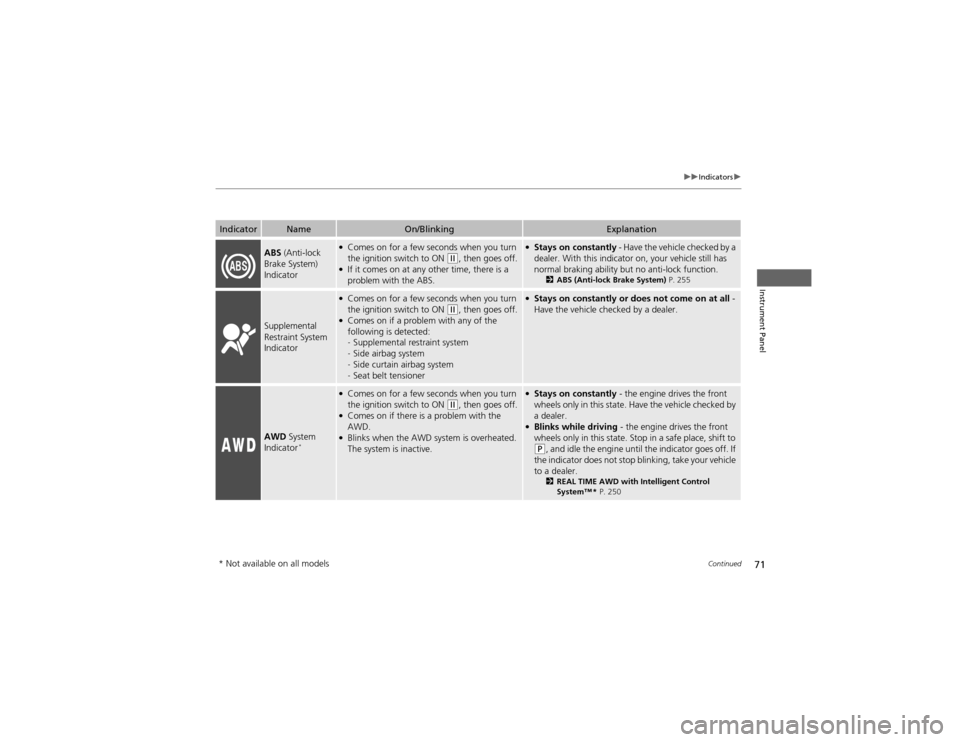
71
uuIndicatorsu
Continued
Instrument Panel
IndicatorNameOn/BlinkingExplanation
ABS (Anti-lock
Brake System)
Indicator● Comes on for a few seconds when you turn
the ignition switch to ON
(w , then goes off.
● If it comes on at any other time, there is a
problem with the ABS.
●Stays on constantly - Have the vehicle checked by a
dealer. With this indicator on, your vehicle still has
normal braking ability but no anti-lock function. 2ABS (Anti-lock Brake System) P. 255
Supplemental
Restraint System
Indicator
●
Comes on for a few seconds when you turn
the ignition switch to ON
(w , then goes off.
● Comes on if a problem with any of the
following is detected:-Supplemental restraint system
- Side airbag system
- Side curtain airbag system
- Seat belt tensioner
●
Stays on constantly or does not come on at all -
Have the vehicle checked by a dealer.
AWD System
Indicator *
●
Comes on for a few seconds when you turn
the ignition switch to ON
(w , then goes off.
● Comes on if there is a problem with the AWD.
● Blinks when the AWD system is overheated.
The system is inactive.
●Stays on constantly - the engine drives the front
wheels only in this state. Have the vehicle checked by
a dealer.
● Blinks while driving - the engine drives the front
wheels only in this state. Stop in a safe place, shift to
(P , and idle the engine until the indicator goes off. If
the indicator does not stop blinking, take your vehicle
to a dealer. 2REAL TIME AWD with Intelligent Control
System